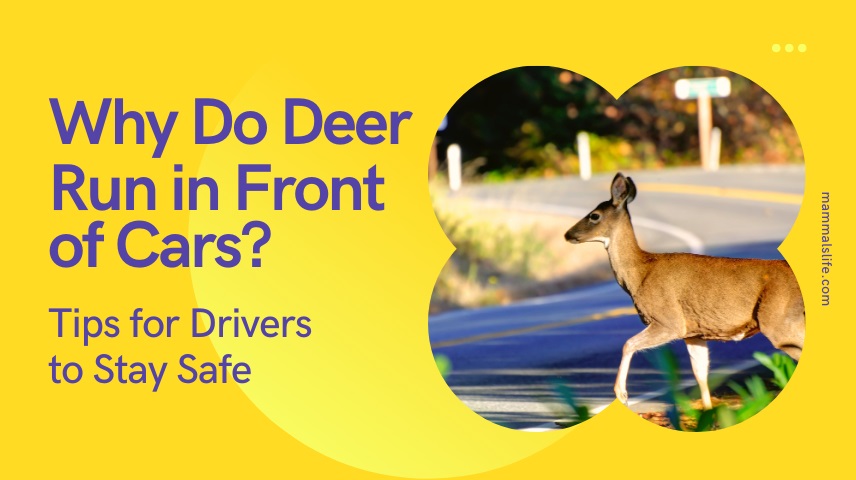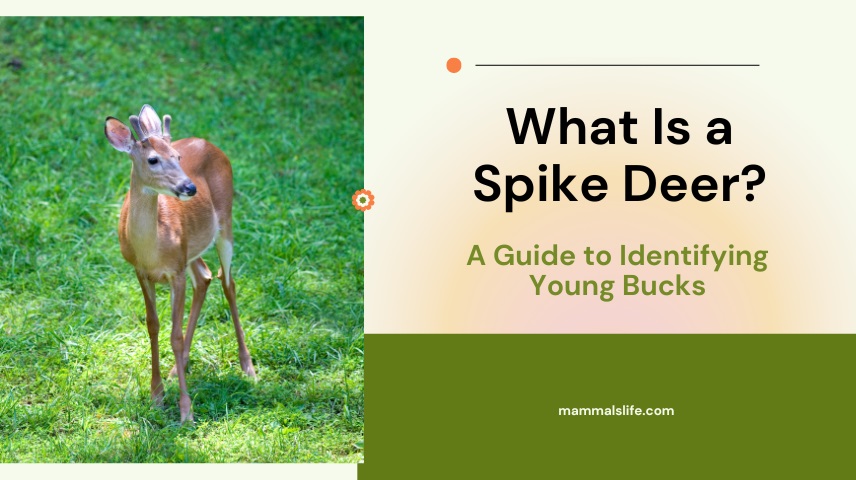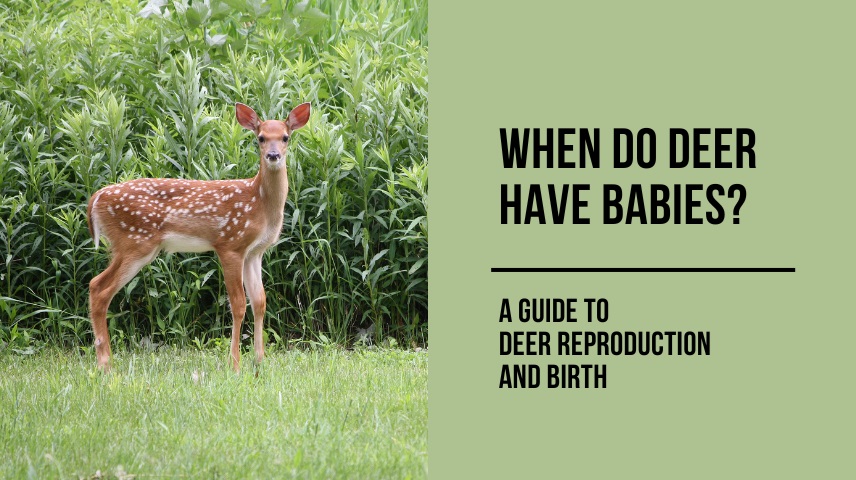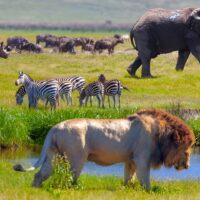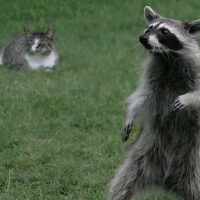Last Updated on February 22, 2025 by Mammals Life
Deer run in front of cars due to confusion and their fight-or-flight response. They often misjudge the speed of vehicles.
Deer are unpredictable animals that can suddenly dart in front of vehicles, especially during dawn and dusk. These times are when deer are most active, increasing the risk for drivers. Understanding why deer exhibit this behavior can help in preventing accidents.
Their sudden movements are driven by an instinct to flee from perceived threats. Drivers must stay alert and take precautions to avoid collisions. This includes reducing speed in areas where deer are common and being extra vigilant during peak activity times. Avoiding distractions and using high beams at night can also improve visibility and reaction time.
Deer Behavior Patterns
Understanding deer behavior patterns can help drivers stay safe on the road. Deer often runs in front of cars due to several factors. Knowing these patterns can reduce accidents and save lives.
Seasonal Movements
Deer change their locations based on the seasons. In the spring and summer, they often stay close to food sources. In fall and winter, they move to find better shelter and food. This movement increases their presence on roads.
| Season | Deer Activity |
|---|---|
| Spring | Searching for new food sources |
| Summer | Staying close to food and water |
| Fall | Moving to find better shelter |
| Winter | Seeking areas with more food |
Mating Season Activities
During the mating season, also known as the rut, deer become more active. They move around more frequently and are less cautious. This increased activity often leads to more deer crossing roads.
- The rut usually occurs in late fall.
- Bucks chase does, leading them to a crossroads.
- Deer are more focused on mating than on their surroundings.
Understanding these behavior patterns can make drivers more alert. Staying aware can help avoid accidents and keep everyone safe.
Read More – What Is Good to Feed a Baby Deer? Safe And Nutritious Food Options
Common Reasons For Road Crossings
Many drivers have experienced a deer suddenly appearing on the road. Understanding why deer cross roads helps drivers stay safe. Deer are creatures of habit and have specific reasons for their movements.
Food Search
Deer often cross roads in search of food. They look for plants and berries that grow near roads. Roadsides can have more vegetation due to less competition. Deer follow these food sources, leading them to crossroads. In the colder months, food scarcity drives deer to wander further. This increases their chances of encountering roads.
Territorial Instincts
Deer have strong territorial instincts. Males, especially during mating season, roam to find mates. This behavior increases road crossings. They also patrol their territory to fend off rivals. This leads to frequent and unpredictable road crossings. Female deer travel with their young, teaching them about their territory. This behavior also results in road encounters.
High-risk Areas For Deer Collisions
Deer collisions can be dangerous for both drivers and deer. Knowing high-risk areas can help drivers stay safe. Deer tend to roam certain areas more frequently. Understanding these can prevent accidents.
Rural Roads
Rural roads are common sites for deer collisions. These roads often cut through natural habitats. Deer cross them to search for food and mates. Drivers should be extra cautious on these roads.
- Use high beams at night, when possible.
- Drive slower during dawn and dusk.
- Watch for deer crossing signs.
Rural roads may lack proper lighting. This makes it harder to spot deer. Always stay vigilant and maintain a safe speed.
Forest Edges
Deer often stay near forest edges. They find food and shelter here. Roads near forests have higher deer activity. Drivers should be extra careful in these areas.
- Reduce speed near forest edges.
- Look for glowing eyes in the dark.
- Be prepared for sudden stops.
Deer usually move in groups. If you see one, expect more to follow. Always be ready to stop or slow down.
Read More – What to Feed a Deer in the Winter? Safe And Nutritious Winter Feeding Options
Driver Safety Tips
Deer running in front of cars can be dangerous. Knowing how to stay safe is crucial. Here are some driver safety tips to help you avoid accidents with deer. Follow these simple steps to stay safe on the road.
Speed Reduction
Reducing your speed can give you more time to react. Always slow down in areas with deer crossing signs. Driving slower helps you stop quickly if a deer appears.
- Slow down in deer-prone areas.
- Keep your speed under the limit.
- Be extra cautious during dawn and dusk.
Deer are more active during these times. Reducing speed reduces the risk of hitting one.
Use Of High Beams
Using high beams helps you see deer from far away. High beams light up the road better. This gives you more time to react.
- Use high beams in low-traffic areas.
- Switch to low beams if other cars are near.
- Look for the reflection of deer eyes.
High beams can reveal deer eyes from a distance. This helps you spot them early and stay safe.
| Time of Day | Action |
|---|---|
| Dawn and Dusk | Reduce speed and use high beams |
| Night | Use high beams, switch to low beams for oncoming cars |
Read More – What to Feed Deer Instead of Corn? Best Practices for Sustainable Deer Feeding
Vehicle Modifications For Safety
Deer running in front of cars can be dangerous. Modifying your vehicle helps increase safety. Simple changes to your car can make a big difference. These modifications can help avoid accidents and keep you safe.
Deer Whistles
Deer whistles are small devices attached to your car. These whistles create sounds that humans can’t hear. Deer hear these sounds and stay away from the road. You can easily install deer whistles on your vehicle.
- Inexpensive and easy to install
- Effective in alerting deer
- Reduces risk of deer-car collisions
Advanced Braking Systems
Advanced braking systems help you stop quickly. These systems use technology to detect obstacles. They apply brakes faster than humans can. This can prevent accidents with deer.
| Type | Benefits |
|---|---|
| Anti-lock Braking System (ABS) | Prevents skidding and maintains control |
| Automatic Emergency Braking (AEB) | Applies brakes automatically when needed |
Installing advanced braking systems can save lives. They are a smart investment for safer driving.
Post-collision Steps
Accidents involving deer can be stressful and confusing. Knowing what to do after a collision can help you stay safe and manage the situation effectively. Follow these steps to ensure you handle the aftermath correctly.
Immediate Actions
Immediately after the collision, turn on your hazard lights. This alerts other drivers to be cautious.
- Check for Injuries: Ensure everyone in the car is safe.
- Move to Safety: If possible, move the vehicle to the side of the road.
- Call Authorities: Contact the police or local wildlife authorities.
- Do Not Approach: Avoid getting too close to the injured deer.
Stay calm and wait for help to arrive.
Insurance Procedures
Once you are safe, you need to deal with your insurance. Follow these steps for a smooth process:
- Document the Scene: Take photos of the accident scene and damages.
- Gather Information: Note the time, date, and location of the collision.
- File a Report: Submit a police report if required by your insurer.
- Contact Insurance: Call your insurance provider to start a claim.
Provide all necessary details to expedite the process.
Frequently Asked Questions
Why Do Deers Stay Still In Front Of Cars?
Deers freeze in front of cars due to a natural defense mechanism called “freeze response. ” They become disoriented by headlights and perceive the threat.
How Do I Keep Deer From Running In Front Of My Car?
Drive slowly in deer-prone areas, especially during dawn and dusk. Use high-beam headlights to spot deer. Install deer whistles on your car. Be extra cautious in rural or wooded areas. Pay attention to deer crossing signs.
Why Do Deer Dart In Front Of Cars?
Deer darts in front of cars due to confusion, escaping predators, or being blinded by headlights. They follow instincts and unpredictable movements.
What Do You Do If A Deer Runs In Front Of Your Car?
Brake firmly but stay in your lane. Avoid swerving to prevent losing control or hitting another vehicle.
Why Do Deer Run Into Cars?
Deer often run into cars due to their instinct to flee from predators and confusion by headlights.
Conclusion
Understanding why deer run in front of cars helps prevent accidents. Stay alert, especially during dawn and dusk. Use high beams when possible and reduce speed in deer-prone areas. Remember, safety comes first. Implement these tips to protect yourself and wildlife.
Stay vigilant and drive safely.

